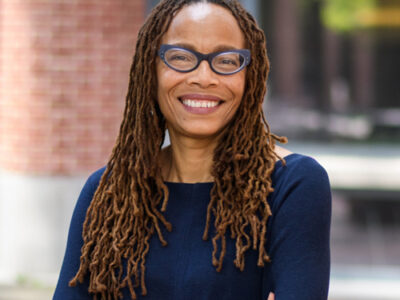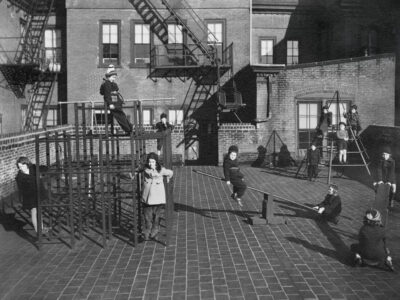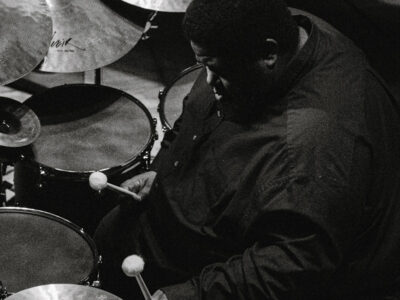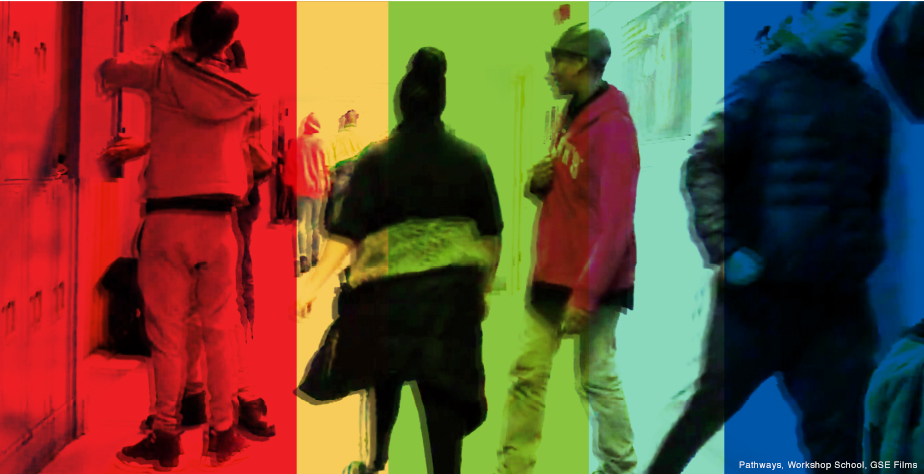
Penn students from a variety of disciplines are learning the essentials of film storytelling and production while helping to give a voice to marginalized people and communities, from Philadelphia’s high schools to a refugee settlement in Kenya to Puerto Rico after Hurricane Maria.
BY DAVE ZEITLIN
SIDEBAR | Art of Recovery: Student filmmakers document artists’ responses to Hurricane Maria.
WATCH | Most of the student films discussed in this article can be found online. Documentaries produced through GSE’s partnership with the School District of Philadelphia are available at: philasd.org/pstv/partnerships/penn-gse-program/. The virtual reality film showing a classroom in the Kalobeyei refugee settlement in Kenya can be viewed at: vimeo.com/233883496. Some films produced through the interdisciplinary group CAMRA at Penn can be found here: camrapenn.org/projects.html
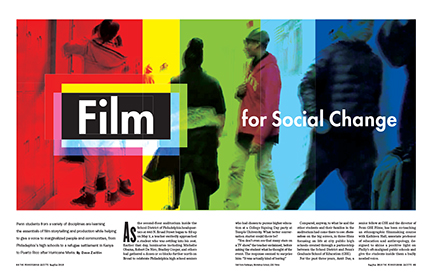
As the second-floor auditorium inside the School District of Philadelphia headquarters at 440 N. Broad Street began to fill up on May 2, a teacher excitedly approached a student who was settling into his seat. Earlier that day, luminaries including Michelle Obama, Robert De Niro, Bradley Cooper, and others had gathered a dozen or so blocks further north on Broad to celebrate Philadelphia high school seniors who had chosen to pursue higher education at a College Signing Day party at Temple University. What better conversation starter could there be?
“You don’t even see that many stars on a TV show,” the teacher exclaimed, before asking the student what he thought of the event. The response seemed to surprise him: “It was actually kind of boring.”
Compared, anyway, to what he and the other students and their families in the auditorium had come there to see: themselves on the big screen, in three films focusing on life at city public high schools created through a partnership between the School District and Penn’s Graduate School of Education (GSE).
For the past three years, Amit Das, a senior fellow at GSE and the director of Penn GSE Films, has been co-teaching an ethnographic filmmaking course with Kathleen Hall, associate professor of education and anthropology, designed to shine a positive light on Philly’s oft-maligned public schools and give the students inside them a badly needed voice.
“What struck me is that at places very close by, there are people going through very difficult times, and sometimes that’s not very visible to us on campus,” Das says in his GSE office a few days before the screening. “There’s a lot we overlook, or don’t look at, and I think we have a responsibility. That’s part of my own training and where I come from in the use of film. My teachers who were documentarians advocated the use of film for social change. And so do I. I’m not sure we can fix things, but we can point people toward looking at them.”
And for the GSE and Penn students who’ve taken it—the majority of whom have had no filmmaking experience before being put through “film boot camp” and sent off to city high schools with cameras—the course has been a “transformative” experience, he adds.
Das has viewed film as a force for good for as long as he can remember. As a child growing up in England, he says his mom would drop him in front of the TV for hours, where he’d watch BBC programs on biology, geography, history, and Greek mythology. After moving to India and earning a degree in economics from the University of Delhi in 1985 (followed by a master’s in mass communications from Jamia University), he produced educational series for Indian television. Coming to the US, he earned another master’s, in cinema studies, at New York University in 1992, while making more documentaries and eventually becoming director of the school’s film, video, and broadcasting department before joining Penn’s faculty in 2005.
Giving Students a Voice
When the School District of Philadelphia approached him with the idea of using video to reach middle schoolers who were contemplating their choice of high school, he saw that the project could be both beneficial for Philly schools and present a terrific teaching opportunity for his own students. After starting with a small pilot program at the Philadelphia Military Academy, the collaboration expanded to John Bartram High School, Paul Robeson High School, and A. Philip Randolph Career Academy for the 2015–16 academic year.
In the course, Das and Hall teach students how to craft a story, along with the basic technology of video cameras and Final Cut editing software, but don’t prescribe what kind of film the teams assigned to each school should make. “That’s for them to discover and articulate to us,” he says.
In the program’s first year, the focus was mostly on representing the schools in a general light; during 2016–2017, they moved more toward collaboration with the high school students. Last year, with teams going into William L. Sayre High School, the George Washington Carver High School of Engineering and Science, and the Workshop School, there was an even greater focus on amplifying the high schoolers’ voices.
When Brittany Horn GEd’18—an investigative journalist with The News Journal Media Group in Delaware, who completed her master’s in education in May—showed up at the Workshop School with fellow GSE graduate student Emily Eckardt and Natalie Kahn, a sophomore in the College, she didn’t presume to know what kind of film they’d make either. At first they didn’t even bring a camera, concentrating on getting to know some of the students and building trust. “We really wanted to make sure whatever film we created, the students felt that it represented them and also allowed them voice and agency in the process,” says Horn.
Through their discussions, a compelling storyline emerged examining the experience of certain Workshop School students who are dually enrolled in college courses. Horn, Eckardt, and Kahn followed these students, cameras rolling, as they navigated the city and “literally transition from high school to college students just on the ride on SEPTA,” Horn says. Some students talked about being the first in their family to go to college. And about feeling more welcome at Community College of Philadelphia, where there were more people of color, than at schools like Drexel and Penn. “They were honest and open with us,” Horn says. “And I don’t think we would have had that trust if we just showed up on the first day with a camera and jammed it in people’s faces.”
Creating the roughly 15-minute documentary film was an eye-opening process technically and aesthetically, too. They didn’t always have the camera on for “those perfect moments.” At times, the lighting wasn’t what they had hoped for. In the editing room, as they raced to complete the film, they wished they had more footage of students interacting. But they say they were pleased with how it turned out in the end—in particular the way they creatively captured the personality of the class by gathering everyone for a group photo while they had no idea the camera was rolling and speeding up the video of the students goofing around and taking their time to assemble, which they used for the closing credits.
Watching the movie for the first time weeks later in the school district auditorium, the students laughed at themselves laughing on screen. Some took selfies in front of their projected images.
In the panel discussions that followed each film, one student admitted to the audience that she was initially skeptical when these Penn people showed up with cameras before realizing it was a chance for their stories to be heard. After watching the film about Sayre High School, which focused on an after-school performing arts space, “Lit Lounge,”—lit meaning “excited, vibrant, enthusiastic,” a title card helpfully explained—one Sayre senior told his classmates, “I look at all of you guys as my family.” During the panel about Carver, a magnet school focusing on STEM fields, where three different students were given cameras to document their daily moments, the school’s film teacher used his time to advocate for more cameras in schools, stressing the power of film.
Watching the public-school students and their teachers, so often marginalized, become movie stars, if only for a couple of hours, also hit home for the Penn filmmakers. “It was the most meaningful work I did at Penn,” Horn says. “I would do it again in a heartbeat. I’ve been telling people this is the class you have to take, even if you’ve never done film before.”
Bringing a Refugee Camp to Life
Peter Decherney, professor of English and cinema studies, is sitting in his Bennett Hall office, more than 7,000 miles from Kenya, where he took a group of student filmmakers in July 2017. But it doesn’t feel that far away. Not as he takes out his iPad and shows a visitor one scene of a 360-degree virtual reality (VR) film he helped create, transporting the viewer to an overcrowded classroom inside a refugee settlement, filled with children singing. “Move your whole body!” Decherney instructs, his voice rising in excitement. “Turn your shoulders! There you go! It’s like you’re in the middle of class!”
Like Amit Das, Decherney is a believer in the power of film to precipitate social change. “The challenge is to tell stories about real people, and not just stories that might reinforce people’s conceptions,” he says. “So I immediately thought about VR as a way to show what life was like at a refugee camp. When I told students where we were going, they couldn’t even picture it.”
The trip to Kenya was made possible by a grant from the School of Arts and Sciences’ Making a Difference in Diverse Communities program, which supports multidisciplinary projects led by faculty teams working with students to address societal challenges, along with a partnership with FilmAid International, a nonprofit humanitarian organization that uses film to educate and entertain displaced people around the world. “FilmAid is essentially film schools in refugee camps, mostly in Africa,” Decherney says.
The Penn group consisted of Decherney, eight undergraduate students, and two teaching assistants. They were in Kenya for 10 days, staying at the United Nations headquarters and waking up at 4 a.m. so they could begin shooting at the Kakuma camp and the newer Kalobeyei settlement by sunrise. Working with refugee filmmakers who were graduates of the FilmAid program, they made several short informational documentaries designed to educate new arrivals at the camp about UN services in areas such as education, health, livelihood, safety and protection, water and sanitation, food distribution, and firewood, as well as the VR movie about the primary school. “One thing I was really happy about is [that] the films had a real purpose,” Decherney says. “They’ve helped hundreds, maybe thousands, of people.”
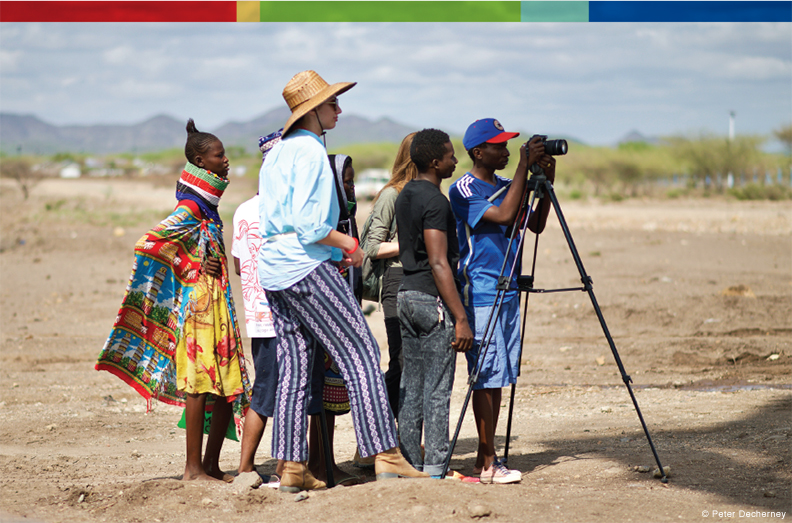
Nicholas Escobar C’18 had never been to Africa before and, like the other students on the trip, had never really seen extreme poverty. What struck him the most was how talented and hopeful some of the FilmAid graduates were—and how eager they were to learn more. Escobar, a composer, gave a lecture on film scoring to students in Kakuma, as well as a tutorial on how to use the music software program GarageBand. Two laptops were left behind, and Escobar also donated a keyboard.
One day, as the sun set, Escobar danced on top of a van to reggae music with teenagers who, Decherney notes, might “have been Penn students if they were born into different circumstances.”
“It really was hard to fully grasp the hardships the students our age have gone through,” says Escobar. “But then through it all, they’re just very strong people and very driven and really want to succeed … They were just as passionate about film as we were, if not more.”
Junior Melisande McLaughlin was also surprised by the “focus on joy” and the “positive energy” she saw among the settlement’s population of displaced citizens of South Sudan, Somalia, Congo, and other surrounding countries, who aimed to create a bustling city in Kakuma (with “every kind of business you can imagine,” Decherney says). She and her colleagues tried to communicate that sense of hopefulness on screen. But there were also moments of despair, which they struggled to portray honestly and sensitively.
The first interview McLaughlin did was with a woman who had three children of her own and was also caring for two more that the camp had “more or less given to her,” she says. They slept on the floor with old blankets in a space that was “probably the size of a Penn dorm room.” Sometimes the woman had to prioritize washing clothes or providing nutrition for her own children over the others. “She had already lost the life she hoped for for her children and was losing that life for other people’s children,” McLaughlin says.
Naturally, the refugee became very emotional as she spoke, sometimes crying, sometimes yelling, with a translator there because she didn’t speak much English. McLaughlin did her best to empathize without offering false hope by promising that the film would change her situation. “You really need to be careful not to re-traumatize them, while at the same time enabling them to feel safe enough to to be able to talk about how they are feeling,” she says. “At what point do you need to stop filming in order to protect the person you are filming? That’s always going to be an important question.”
Even while striving to be realistic about how helpful Penn’s presence could be in any individual case, McLaughlin doesn’t downplay the importance of film in general. “Film, in my mind, is the most powerful creative medium in enabling others to understand the world,” she says. She hopes to be a director one day and to continue to “make films that can bring about social change.”
That’s a sentiment shared by the FilmAid alumni they encountered, she says. “I feel like I learned a lot from them—probably more than they learned from me.” She adds that the movies the refugees make are not only an outlet for their creativity and emotions but also might provide the chance to get to a film festival in Nairobi and even create a better life for themselves.
The Penn students report it was tough saying goodbye to their new FilmAid friends, but many have stayed in touch since. And Escobar and another student on the trip, rising junior Sonari Chidi, also launched a FilmAid club at Penn upon their return to the US, which they believe to be the first on a college campus.
At an activities fair on Locust Walk in August 2017, the club generated a lot of interest thanks in large part to VR headsets at their table. Its listserv grew to around 100 members. Members can learn about editing, cinematography, and, of course, virtual reality. The club has several projects on the docket for this fall, including making promotional films for the African Family Health Organization (a West Philadelphia nonprofit that connects African and Caribbean immigrants and refugees to healthcare needs and educational services) and creating VR movies about West Philadelphia businesses to perhaps “break the stigma that Penn students can’t go past 47th Street,” Escobar says.
Decherney, the FilmAid club’s faculty advisor, says it’s “been incredible to see the momentum and interest they’ve built,” which has included winning a Sol Feinstone Undergraduate Award recognizing “orderly and constructive social and educational change within or outside the University community.”
“One of our main things is to help refugees tell their own story through film, because that’s what FilmAid does, and that’s what they really believe in,” says Escobar, who after graduation was planning to write music for media, while still keeping close ties with the club he cofounded. “It’s been a strong start, and we’re going to keep building. I see the group lasting a very long time.”
Nurturing “Multimodal” Scholars
When John Jackson was in graduate school in the 1990s, he hid the fact that he made movies from his advisors and swore his fellow students to secrecy for fear that he wouldn’t be taken seriously as an academic if word got out about his penchant for filmmaking [“John Jackson, Ethnography, and the Hebrew Israelites,” Mar|Apr 2014].
Times have changed. Jackson—the Richard Perry University Professor of Communication, Africana Studies, and Anthropology, who currently serves as dean of the School of Social Policy and Practice and will become dean of the Annenberg School for Communication in January—has pushed to make filmmaking an integral part of the curriculum, so that today’s generation of students will reach for a video camera “unthinkingly, the way they turn on a computer or pick up a pencil.” He’s felt that way ever since arriving at the University more than a decade ago as the first Penn Integrates Knowledge (PIK) Professor, hoping to nurture the development of “multimodal” scholars.
“When I got here I was chomping at the bit, and there was a critical mass of students already who wanted to work in film,” Jackson says. “We’ve done a ton of interesting work that’s all about saying, ‘What does it mean to get academia to recognize that this is a valid way to produce scholarship?’ If anything, it’s more complicated than writing a journal article or a book.”
Widespread preconceptions about the medium are one obstacle. “People assume if you’re working in film, you’re trying to reach larger audiences and talk to the masses and make a million dollars,” he explains. “Some people are. But what if you’re trying to work in film because you’re using that multimodal format to speak to other scholars about the issues you care about as an academic?”
Six years ago Jackson and Amit Das co-taught an urban ethnography class that centered around making documentaries at West Philadelphia High School, an “incredibly ambitious project” that was a precursor to Das’ current GSE course. In the midst of mastering film technology, Jackson’s students also had to learn about the high school in a “larger political and social context.” It was a lot to ask of students, and Jackson admits he “pushed them all into the deep end of the pool”; participants had to “learn on the fly, so they didn’t have time to be afraid,” he adds.
He could tell right away it was the start of something special, despite some initial skepticism and suspicion. “When we came back after the first session, it was almost like we had to have an intervention with our students because it was clear that the West Philly High students didn’t trust us,” Jackson says. “But once they started to connect with our students, once our students really began to demonstrate they were going to be with them for the entire semester, and would work hard with their sleeves rolled up, I think they produced some really powerful pieces.”
Among them were “riveting” documentaries in which students discussed police brutality, filmed in their second year going into West Philly High after having built a stronger rapport with students. In 2015–2016, Arlene Fernandez C’07 SPP’17 dealt with many of the same issues when she took the ethnographic filmmaking course offered through GSE, having sought it out after a fellow social work student told her about the earlier class co-taught by Jackson and Das.
Fernandez was part of a team that went into John Bartram High School shortly after Fox News had run a segment on a violent incident inside the school, heightening suspicions about her intentions. “Are you from Fox News?” she remembers being asked, as she lugged in cameras. But Fernandez, long interested in social justice and understanding the importance of creating a multi-dimensional portrayal of a struggling school, charged forward undeterred.
“We didn’t walk in with a goal in mind, but I think it became clear as we spent time there that we felt there was a need for some counter-narrative,” she says. “We tried to be really intentional and thoughtful and put all of our best efforts to portray this community in a beautiful way—in a way that we really saw them.”
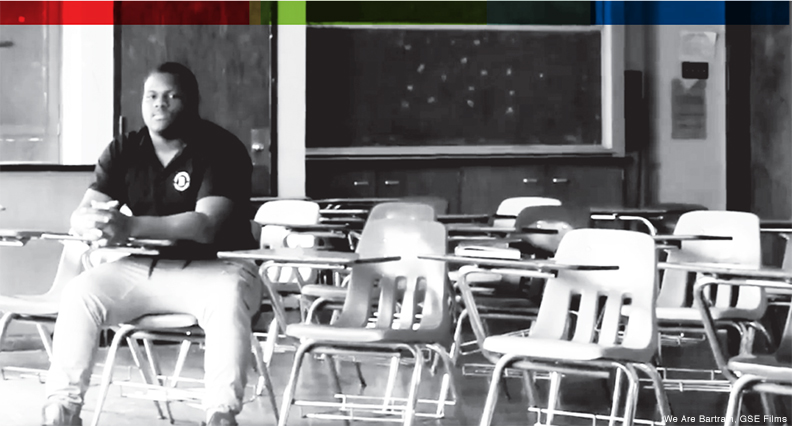
The reason they saw them in a positive light is, quite simply, because they were there. They were there at prom, and at graduation, and even after they stopped filming, developing meaningful relationships along the way. So by the time a new group of students returned to Bartram for the same course the following year (the kind of continuity Das believes to be important) there were fewer trust issues—not to mention improvements in the technical aspects of filmmaking.
Fernandez has been a TA in the class over the last two years, improving her own editing skills (“much more time consuming than people realize,” she says) and trying to add sophisticated production value to the films, which this past year included a behind-the-scenes documentary she helped create on the Penn students doing their work. Having worked closely with Das, she says he “really believes in the power of film to be a vehicle of social change and social transformation” and has an “urgency” to teach others to think the same way. “From my perspective,” she adds, “this has been extraordinarily meaningful, and has changed the direction of my life, in some ways.”
It’s also significantly affected the lives of some of the high schoolers, who receive mentoring from the Penn students and also have the opportunity to use the video equipment and learn the craft of filmmaking themselves. Shelly Wolfe, who manages media and production services for the School District’s educational channel, PSTV, where the films are broadcast (as well as being made available on YouTube and PSTV’s website), says she knows of at least three students who decided to go to film school. She’s also gotten emails from parents who decided to keep their kid in a neighborhood school after viewing the films, and another from someone who said she’s considering moving to the Philadelphia area because of a focus on media hubs inside schools.
“Sometimes Philadelphia schools might get a bad rap, and this is a great opportunity to highlight the work students are doing and how engaged they are in their schools,” says Wolfe, a Silicon Valley transplant who came to Philly three years ago. “The stories are told by the students—and what’s more powerful than really hearing it from their mouths?”
Wolfe hopes to see the partnership with Penn GSE continue to expand. Currently any school in the district is eligible to apply, and the Netter Center for Community Partnerships assists with the clearance process for Penn students. She’d also like to see more local universities partner with the district so more schools can be included.
Wolfe thinks the documentaries are getting better and better every year. “The students have done a great job,” she says, “and there are a few that will definitely make you cry.”
Braving New Frontiers
Melisande McLaughlin’s appreciation for the intersection of the arts and social change began in Thailand, where she grew up. In the wake of the 2004 tsunami, her mom decided to create an art collective for people dealing with trauma.
This spring, as McLaughlin prepared to leave for another trip Decherney had coordinated through a Making A Difference in Diverse Communities grant—this one to Puerto Rico and focusing on artists’ responses to Hurricane Maria and the recovery effort—she couldn’t help but see a lot of parallels. “I see it as being very similar to Thailand after the tsunami,” she said. “I think there’s going to be a lot of sadness. But the focus on the arts for the film is always searching for the light in it. And I think the arts, for a lot of people, are that light, that source of hope.”
To be able to travel with students to a different country for a second straight summer is an “amazing opportunity,” Decherney said. He hoped to ramp up the group’s work in virtual reality filming, which they’ll teach at schools and at different organizations in Puerto Rico. After shooting their own VR film, with the help of Puerto Rican filmmakers, they also planned to leave some VR cameras behind, just as they did in Kenya. “We want to be the Johnny Appleseeds of the VR world,” Decherney said, broadening use of the technology beyond its current primary audience of high-end gamers.
McLaughlin had never made a VR film before she set up a 360-degree camera in a Kenyan school two summers ago (among her favorite parts there was capturing a son and father in the same classroom), but was excited to do it again in Puerto Rico. “And I hope I’ll get to do it for the rest of my life,” she added, calling VR an important tool in documentaries to “develop the empathy required and be pushed to take action.”
It’s an approach that McLaughlin, who transferred from Middlebury College to pursue a major in film, is glad to see Penn embracing. “I knew Penn was very focused on social engagement and supporting projects for good causes,” she said. “And I do think the film department and organizations around campus are growing very rapidly.”
Nicholas Escobar—whose brother Alec, a rising sophomore, was going on the Puerto Rico trip—admitted he didn’t anticipate the kind of “amazing film community” he’d find at Penn. In addition to scoring films in Kenya and launching the FilmAid club, he also joined the Kinoki Senior Society, founded in 2014 for students pursuing careers in entertainment, and was helped by Decherney to land Hollywood internships as well as musical gigs for local production companies. He said he’s glad he didn’t pigeonhole himself at a conservatory to study composition, which he initially thought he might do, or even attend a college with a larger film department.
“I think we have the ideal film program,” Decherney says. “Prospective students come in all the time and say, ‘Should I go to USC, NYU, or Penn?’ And [my] answer is always, ‘You should go to Penn.’ Not because I’m here, but because I think it’s a mistake as an undergrad to limit yourself to such a specialized program. I think you’re always going to be a better filmmaker if your film program is rooted in a broader liberal arts education.”
To back up his claim, Decherney points to film projects underway at several schools and departments throughout the University, many geared toward addressing real-world problems. From Professor Regina Austin L’73’s documentary film production course at Penn Law [“Legal Zoom-In,” Nov|Dec 2016] to the digital media design program training animators and game designers at the School of Engineering and Applied Science [“The Cult of DMD,” Sep|Oct 2003] to a project teaching people how to use CPR through VR at Penn Nursing to films being created in Wharton’s marketing department, Penn GSE, and more, Decherney called it “something that’s special at Penn”—and a critical aspect of preparing students to adapt to a digital world (and not necessarily for Hollywood careers).
“Increasingly, students want to be YouTube directors, and they want to have a great YouTube channel,” Decherney says. “Ten years ago, everyone wanted to be a movie director. Maybe five years ago, everyone wanted to be a showrunner. And now everyone wants a YouTube channel.”
Amit Das compares video to food: “something we all consume, something we all have in common, and [that] can be the conduit between people of different backgrounds.” At the same time, it’s a craft that has to be recognized and mastered. (Too many eat without thinking.)
Das begins his ethnographic filmmaking course by asking the class to write their names by hand, and then write them again, only using the other hand. “And I say, ‘That’s what the next semester is going to feel like,’” he says. “I think most people are functionally illiterate in film, even though it’s a really preponderant means [through] which we form our ideas of the world.”
While “it might be cool if that happened,” Das says his goal is not to turn students of education into filmmakers but to help educators incorporate film methods into whatever work they end up doing. And he hopes his filmmaking program, which he believes to be one of the country’s first in a graduate school of education, eventually becomes less unique as others follow suit. “I think it’s really important for everybody to be more conversant in film,” Das says. “You don’t do it by watching. You have to make it.”
From his vantage point, John Jackson has seen students grow more conversant with the art of film and is encouraged by the University’s growing commitment to the medium. Jackson is a founding member of CAMRA, an interdisciplinary collective of researchers and educators committed to participatory, experimental media-making. He calls the group’s annual media festival “one of the most exciting weekends of the year.” And it’s a source of pride that Annenberg and GSE students have become “the first in the history of the University of Pennsylvania to graduate with a visual dissertation,” he says. Some of those students have since gone on to teach film at other institutions, continuing to push the academic world toward acceptance.
“We’re attracting fantastic students who want to work multimodally and know they can do it here and do it well,” he says. “And they know they can have a career when they’re done.”
Like Decherney, Jackson is excited by how widespread and varied filmmaking is across Penn, and by how much better the production value has become. There are people in the sciences, he says, making some “really high-end glossy films” designed to educate the public. There’s an Annenberg-funded documentary project on the founding of HBO that’s been a few years in the making, which Jackson hopes will get picked up by Netflix or PBS. And he’s helped to fund and support an ambitious documentary project on black gay men in the South, spearheaded by Nora Gross, a PhD student pursuing a joint degree in education and sociology.
The best part? As more of these documentaries come out, the less unorthodox they will seem and, perhaps, the more resources will be devoted to film—whether that means bringing cameras into a high school down the street or to a refugee camp across an ocean.
“I can’t wait to see how this all unfurls,” Jackson says. “I think it’s only just begun.”
Sidebar
Art of Recovery
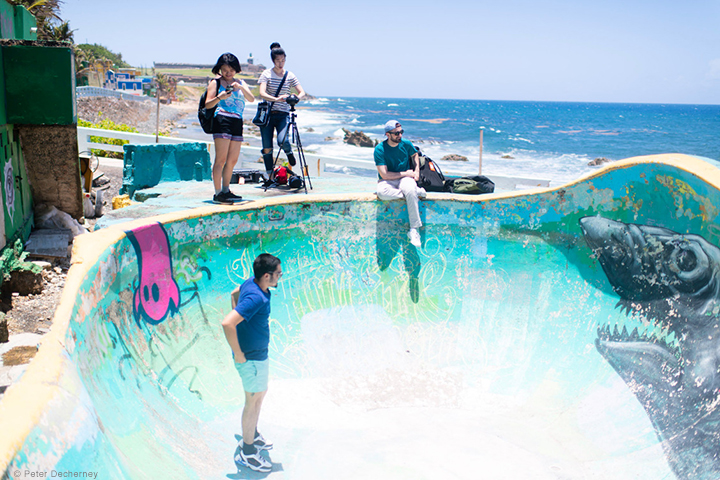
Student filmmakers document artists’ responses to Hurricane Maria.
Peter Decherney and his crew of student filmmakers are learning on the fly when it comes to creating virtual reality (VR) documentaries.
So when one of the two teams’ cameras broke while shooting a drag show in the Puerto Rican capital of San Juan this past summer, Decherney, professor of cinema & media studies and English, tried to use it as a teaching opportunity.
“The funny thing about VR is you have to hide when shooting. We always say, ‘Lights! Camera! Hide!’” he says, shortly after returning from Puerto Rico, where he and five Penn students spent about two weeks documenting artists’ responses to Hurricane Maria and the recovery effort.
“We left one of our cameras alone for two minutes and someone must have knocked it over,” he says, explaining the equipment problem. “But it brought our two teams together. Once we came together as one team, with one camera, it changed the dynamic.”
The result, Decherney hopes, will be a compelling document that captures music, art, and street performances in all their 360-degree glory, transporting viewers to the gritty island that was ravaged by a vicious hurricane last September. To set the scene of the deadly effects of the storm, Decherney and his team relied on interviews with Puerto Rico governor Ricardo Rossello as well as a network of Penn alumni, including Christina Nieves C’10, who founded a nonprofit organization to give Puerto Ricans support and entertainment after the hurricane [“Healing the Island,” May|Jun 2018].
“We had an amazing range of material, from the governor to a drag show to lots of artists who exhibit contemporary art,” Decherney says. “One artist that we were amazed by is a skateboarder; he and his friends skateboard on canvases and then put them on the wall and they look like art.”
Decherney recounts another anecdote from a town called Orocovis, where for many years people told a fable about a mango tree. After the tree was destroyed by the hurricane, the people of Orocovis created a new fable in which “the mangoes left the tree and each one started its own new story,” he says.
The Penn filmmakers—who were “tireless” in their efforts to get as much material as possible, Decherney says—rushed to Orocovis as soon as they heard about this and ended up being amazed by what they shot. “One thing we saw is things now, a year later, are very hopeful,” he adds.
Decherney saw a similar kind of resolve in the face of adversity when he took a group of student filmmakers to refugee camps in Kenya last year [see main story above]. Both that trip and the journey to Puerto Rico were made possible by grants from the School of Arts and Sciences’ Making a Difference in Diverse Communities initiative.
“This was, technically a much more complex, sophisticated production than last year,” Decherney notes, pointing as an example to the “dramatically improved” editing skills of one student, Melisande McLaughlin, a College junior who participated in both trips, from one summer to the next. “We definitely took a lot of lessons we learned in Kenya and brought it to this film.”
Decherney plans to return to Puerto Rico this winter to show the completed film at a festival and perhaps present it as a museum installation. He’s also eager to see what the budding filmmakers in Puerto Rico produce with the 360-degree cameras and VR headsets his team left behind, as they did in Kenya.
“It’s both a sad and a happy story at the same time,” he says. “Institutions that should have helped them failed. But what came out of that is a new sense of independence and community and an embrace of renewable energy and local agriculture and things we see as a fundamental part of culture and society going forward.” — Dave Zeitlin C’03
Dave Zeitlin C’03 writes frequently for the Gazette.


